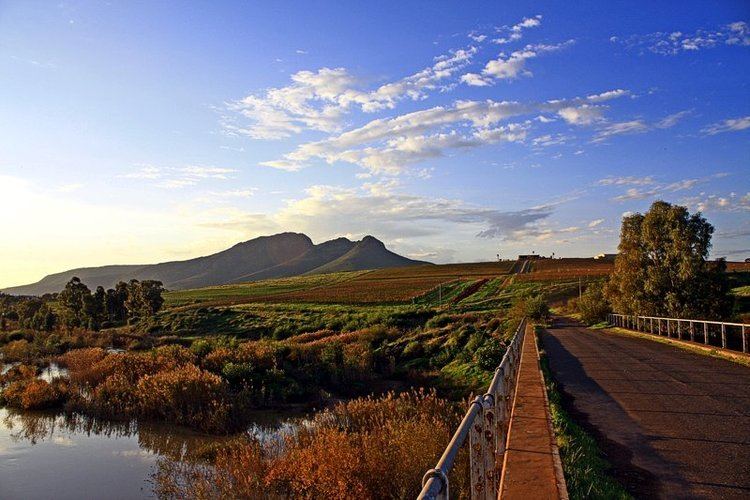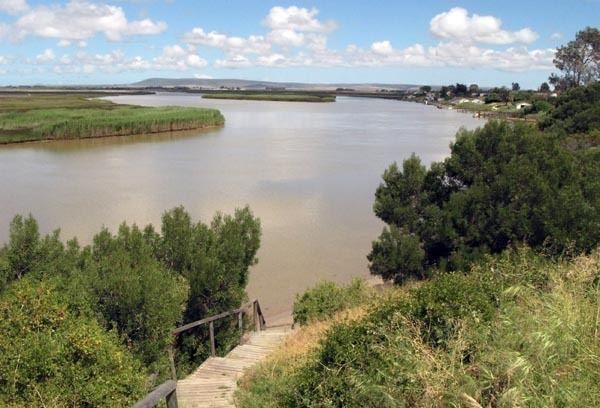Basin area 7,715 km² Basin area 7,715 km² | - elevation 1,000 m (3,281 ft) - elevation 0 m (0 ft) Length 294 km Province Western Cape | |
 | ||
Berg river marathon day 1 win
The Berg River (also called Great Berg River or in Afrikaans: Bergrivier) is a river located just north of Cape Town in the Western Cape Province of South Africa. It is approximately 294 km (183 mi) long with a catchment area of 7,715 km² (2979 mi²) and outlets into the Atlantic Ocean. About 65% of the Berg River area is under agriculture. The major towns in the Berg River area are Velddrif and Laaiplek near the coast, Piketberg, Hopefield, Moorreesburg and Darling further inland, and Wellington and Paarl in the upper catchment. The lead source of the Berg River is south of Franschhoek in the Drakenstein Mountains.
Contents

The Great Berg River can be subdivided into the following segments:

Berg river canoe marathon 2016 day 1
History

The first known European record of the Berg River was made by bailiff Abraham Gabbema in 1657 when Dutch Governor Jan van Riebeeck sent him to trade with the Khoekhoe for meat for the settlement at the Cape. Gabbema named the river the ‘Groot Berg Rivier’. In years to follow many of van Riebeeck’s men relied on the river waters and followed its winding course as they ventured northwards. Despite Gabbema’s visit, the Berg Catchment was not developed until Governor Simon van der Stel’s time (1679–1699), prior to which settlement was limited to the Peninsula. Governor van der Stel visited the area with the first free burghers, and prompted by the Berg River’s fertility and beauty, he established the first European settlements at Paarl and the Drakenstein valley in 1687. Wellington, Franschhoek and Tulbagh were established shortly after this as the farmlands expanded.
Ecology

Extract from the River Health Programme report: “Historically, the Berg River was one of many habitats in the Cape inhabited by hippos but, in the late 1600s, hunters began overexploiting the hippos for their meat and hides, resulting in a decline in their numbers. By the mid-1700s, they had declined to such an extent that governor Tulbagh introduced a fine of 1000 guilders for anyone caught killing a hippo. Despite this protection, their numbers continued to dwindle as human settlement altered and destroyed their habitat. By the early 1800s, perhaps only a dozen remained, sheltering in the region of Kersefontein and the estuary. In 1829, only six hippos remained. The last known hippo was shot in 1869 by Martin Melck when it attacked and killed one of his employees.” See Skead for more details.

The Berg River's native fishes contain some species which are endemic to the region such as the Cape galaxias (Galaxias zebratus). They have been adversely affected by unsustainable human use of the water, but mainly by expanding stocks of exotic fishes, which were originally introduced to establish a European-type fishery. Most problematic among these is the predatory Smallmouth Bass (Micropterus dolomieu). The Berg-breede River Whitefish (Barbus andrewi) – listed Endangered in the IUCN Red List – seems to have disappeared from the Berg River proper in recent times; this large species it survives elsewhere and may be suitable for fishery or aquaculture. The Berg River Redfin (Pseudobarbus burgi) has one of its last major populations in the Berg River; its decline there seems to have stopped or at least slowed, but it too is already listed as Endangered by the IUCN. Trout are also a problem in the upper Berg river.
